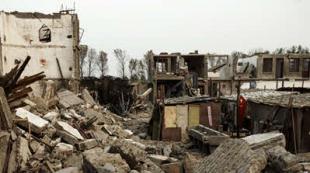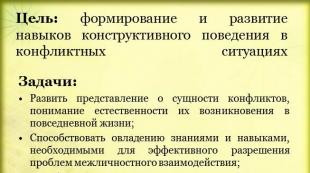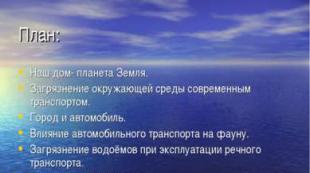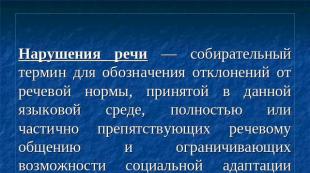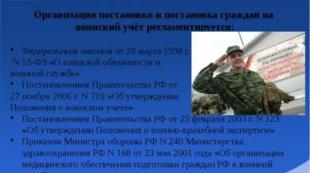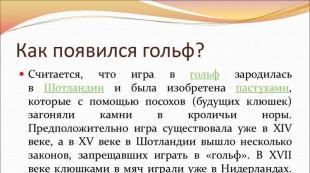Physical and chemical phenomena. Chemical reactions. Presentation on the topic "Physical and chemical phenomena" In all limits
Explanatory note
Introduction (7 hours)
Bodies and substances (19 h)
Temperature. Thermometers.
Divisibility of substances. The structure of the atom and ion.
Solutions and suspensions.
Class
Physical and chemical phenomena (8 hours)
Chemical reactions are the processes of formation of some substances from others. Signs of chemical phenomena and conditions for their occurrence.
Explanation of the course of chemical reactions from a molecular point of view. The breakdown of substances and molecules into atoms or ions, the formation of new substances from them. Conservation of the mass of substances in chemical reactions.
Repetition of signs of chemical elements. Reactions of connection and decomposition. Drawing up equations for the reactions of combination and decomposition.
Substances in nature. The concept of classes of inorganic and organic substances (15 hours)
Oxides are complex substances consisting of two chemical elements, one of which is oxygen. Examples of the most common oxides, their distribution in nature and use.
Acids. Basic information about acids, examples of the most common acids. The use of acids in the economy and everyday life. Rules for handling acids. Acid recognition.
Foundations. General information about bases, soluble bases - alkalis; lime water, slaked lime. The use of foundations in the national economy, everyday life. Rules for dealing with bases. Reason recognition. Neutralization reaction.
The concept of indicators. Action of acids and bases on indicators.
Salts are complex substances, which include metal ions and acid residues. Examples of salts, their distribution in nature. Properties and uses of a number of salts: table salt, soda, copper sulphate, etc.
organic and inorganic substances. Proteins, fats and carbohydrates as the most important nutrients for the human body. Recognition of some proteins, fats, carbohydrates.
Natural gas and oil. The origin of natural gas, oil, coal as decay products of various organic residues without air at high pressures. The most important oil and gas fields in Russia, their importance as sources for obtaining various types of fuel and as the most important raw material for the chemical industry.
Man and nature (11 h)
Energy sources. Various types of energy sources: solar energy, mineral fuel, nuclear fuel. flammable energy sources. Digestion as a process of replenishment of energy by a person. The importance of solar energy for life on Earth.
Outstanding natural scientists, their role in creating the foundations of natural science. The main directions of modern scientific research in the field of physics and chemistry.
The need to create artificial materials. Examples of artificial materials and their use: ceramics, ferrites, superalloys, artificial diamonds, liquid crystals, etc. Information about the methods of growing artificial crystals. Instructions for conducting a home experiment on growing a crystal.
Polymers. Polyethylene, PVC, polystyrene and other plastics. natural and man-made fibres. Use of these materials in everyday life.
Rubber and rubber. Recognition of natural and chemical fibers. Rubber, its properties and production. Vulcanization of rubber, rubber and ebonite.
Environmental pollution. The main factors of the harmful effects of human activities on the environment. Environmental disasters, military operations. Harmful production emissions. The need to control the state of the atmosphere and the main ways of its implementation. The need to combat environmental pollution.
The need to conserve natural resources and use new technology. Discussion of the ecological state in the school and in the territory adjacent to it. Drawing up a plan of specific cases to improve the environmental situation, which can be completed during the summer school practice.
Modern science and production. Means of communication. Knowledge, their role in human life and society. How people learn about the world around them (science yesterday, today, tomorrow).
Production management: the role of automation, electronics. Computerization of production. Robots.
Means of communication and transmission of information: telephone, radio communication, television.
PHYSICS QUESTIONS
1. What does physics study? Physical body, physical phenomenon, physical quantity, substance.
2. Measurements. Measuring instruments.
3. Aggregate states of matter.
4. Movement and interaction of particles of matter.
5. Mass of matter. Density.
6. Interaction of bodies. Strength.
7. Body pressure on the support.
8. Pressure in liquids and gases.
9. Mechanical movement. Speed
10. Thermal expansion. Heat transfer
11. Electrification of tel.
12. Electric current. Current sources.
13. Light sources. Reflection and refraction of light.
14. Simple mechanisms
15. Permanent magnets. Magnetic interaction
Approximate practical tasks
Draw a table in your notebook and distribute the following words in it: lead, thunder, rails, snowstorm, aluminum, dawn, snowstorm, moon, alcohol, scissors, mercury, snowfall, table, copper, helicopter, oil, boiling, blizzard, shot, flood .
Carefully pour a full teaspoon of granulated sugar into a glass filled to the brim with tea, then the tea will not overflow the edge of the glass. Why?
Why do we know what kind of dish is being prepared when passing by the dining room?
In which shoes do feet freeze more: spacious or tight? What role can a woolen sock play?
Why are the handles of nippers always longer than the cutting part?
Explanatory note
The proposed program is implemented in the textbook “Introduction to natural science subjects. Natural science. 5-6 grades”, authors A.E. Gurevich, D.A. Isaev, L.S. Pontak.
The program is compiled on the basis of the fundamental core of the content of general education and the requirements for the results of mastering the main educational program of basic general education, presented in the Standard of Basic General Education.
Introduction (7 hours)
Nature is living and non-living. Natural phenomena. Man is part of nature. Man influences nature. The need to study nature and respect for it. Protection of Nature.
Chemistry is the science of nature. bodies and substances. What does chemistry study. Scientific methods of studying nature: observation, experience, theory.
Acquaintance with the simplest chemical equipment: test tube, flask, beaker, funnel, pipette, spatula, plastic and metal stands, test tube holder. Heating device, features of the flame. Rules for heating a substance.
Measuring instruments: scales, thermometer, beaker (units of measurement, instrument scale, division value, measurement limit, rules of use).
Bodies and substances (19 h)
Characteristics of bodies and substances (shape, volume, color, smell). Solid, liquid and gaseous states of matter.
Temperature. Thermometers.
Divisibility of substances. Molecules, atoms, ions. The idea of the size of the particles of matter. The movement of particles of matter. Relationship between particle velocity and temperature. Diffusion in solids, liquids and gases. Interaction of particles of matter and atoms. Explanation of the structure of solids, liquids and gases from a molecular point of view. The structure of the atom and ion.
Chemical elements (oxygen, nitrogen, hydrogen, iron, aluminum, copper, phosphorus, sulfur). Signs of chemical elements. Periodic system of D.I. Mendeleev.
Simple and complex substances (oxygen, nitrogen, water, carbon dioxide, salt).
Oxygen. Combustion in oxygen. Photosynthesis. Air is a mixture of gases.
Solutions and suspensions.
Water. Water as a solvent. Purification of natural water.
Physical and chemical phenomena (8 hours)
Melting and solidification. Melting snow, freezing water, smelting iron and steel, making parts by casting.
Evaporation of liquids. Condensation.
CHEMICAL AND PHYSICAL PHENOMENA The purpose of the lesson:
- expand understanding of physical and chemical phenomena; establish what signs make it possible to distinguish physical phenomena from chemical ones;
- develop observation skills, the ability to competently handle substances;
- to cultivate attention, the ability to participate in the discussion, respecting the opinions of other people;
melting
crystallization
condensation
evaporation
Physical phenomena in chemistry
Filtration
Distillation
Evaporation
Physical and chemical phenomena
LIGHTNING
Physical and chemical phenomena
Physical and chemical phenomena
Eruption
Physical and chemical phenomena
Physical and chemical phenomena
Leaves in autumn
Physical and chemical phenomena
Fire in the forest
Physical and chemical phenomena
Machine corrosion
Physical and chemical phenomena
melting ice
Physical and chemical phenomena
leaf rot
Physical and chemical phenomena
Sauerkraut
I AM IN L E N I
F Y Z I CH E S K I E
H I M I CH E S K I E
Signs of a chemical reactionRelease or absorption of heat
Change
Precipitation (dissolution) of the precipitate
Selection
Selection
Conditions for the occurrence and course of chemical reactions
catalyst
The heating
ultraviolet
exposure
Experience 1. Swimming paraffin.
A piece of paraffin was placed in a porcelain cup and heated. After melting the paraffin, the flame was extinguished. When the cup had cooled, the paraffin was examined.
Write down the observations (fill in the gaps in the sentences). What is this phenomenon?
Observations. When paraffin is heated, it ________, goes into the _____ state.
Conclusion: This is a _____________ phenomenon.
Experience 2. Evaporation of water.
Pour some water into a beaker and heat it up.
Observations: When heated, the water boiled, while changing its _________________
Conclusion: This is a _________________ phenomenon.
Based on the experiments, tell me what phenomenon is called physical?
PHYSICAL phenomena are called such phenomena in which these substances do not turn into others, there is a change in the state of aggregation of the substance or its form.
- H₂O - liquid - steam - ice
Experience 3. "Soda dissolution".
To a white crystalline substance (soda), we add acid (acetic vinegar). Record your observations. What is this phenomenon?
Observations. At the same time, there is a rapid release of _______. The ghost of transformation is the selection of _______.
Conclusion. This is a ____________________ phenomenon.
Experience 4. "Interaction of solutions".
Pour a blue salt solution (CuCl₂) and a colorless solution - NaOH into a test tube. Record your observations.
What is this phenomenon?
A sign of transformation is the loss of ____ and _____ colors.
Conclusion. This is a _________________ event.
Find a match. Option 1: Option 2:
- melting paraffin
- Rotting plant debris
- Metal forging
- Burning alcohol
- Souring apple juice
- Dissolving sugar in water
- Blackening of copper wire when annealed
- freezing water
- Souring milk
- frost formation
physical phenomenon
chemical phenomenon
2. Which of the phenomena are chemical?
1) freezing water
2) burning sulfur
3) decomposition of mercury oxide when heated
4) melting of metals
5) candle burning
6) air liquefaction
7) burning natural gas
1. Which of the phenomena are physical?
a) boiling water
b) decomposition of water by electric current
c) interaction of zinc with hydrochloric acid
d) metal melting
e) melting snow
e) decomposition of carbonic acid into carbon dioxide and water
g) freezing of water.
CHEMICAL AND PHYSICAL PHENOMENA
Physical: Chemical:
a–d–e–g 2–3–5–7
Homework Level I: - Read §25 and §26,
- Expand the essence of the basic concepts (p. 138);
- Answer orally questions #1-#6 (p. 139). Level III: the message "Chemical reactions in our kitchen" or a crossword puzzle, puzzles based on the material §25 and §26.
Bibliography:
- Lightning - http://900igr.net/kartinka/pri
- Evaporation - http://www.edu54.ru/node/23215
- Volcanic eruption - http://video.nur.kz /vieut=3xjdf
- Frost - http://blog.privet.ru/user/pe
- Rain - http://pda.privet.ru/post/1251
- Leaf rot - http://modbiol.ru/forums/index
- Fog - http://anttila.ucoz.ru/forum/1
- Fire - http://www.kurer-sreda.ru/2011
- Melting ice - http://school.xvatit.com/index
- Corrosion of metals - http://www.pocketfives.com/f13
- Sauerkraut - http://www.liveinternet.ru/we
- Autumn leaves - http://2krota.ru/pictures/page
- Burning gas - http://vidomosti-ua.com/popula
>> Physical and chemical phenomena (chemical reactions). Experimenting at home. External effects in chemical reactions
Physical and chemical phenomena (chemical reactions)
The material of the paragraph will help you find out:
> what is the difference between physical and chemical phenomena.(chemical reactions);
> what external effects accompany chemical reactions.
In the lessons of natural history, you learned that various physical and chemical phenomena occur in nature.
physical phenomena.
Each of you has repeatedly observed how ice melts, water boils or freezes. Ice, water and water vapor consist of the same molecules, therefore they are one substance (in different states of aggregation).
Phenomena in which a substance does not change into another is called physical.
Physical phenomena include not only the change of substances, but also the glow of hot bodies, the passage of electric current in metals, the spread of the smell of substances in the air, the dissolution of fat in gasoline, the attraction of iron to a magnet. Such phenomena are studied by the science of physics.
Chemical phenomena (chemical reactions).
One of the chemical phenomena is combustion. Consider the process of burning alcohol (Fig. 46). It occurs with the participation of oxygen, which is contained in the air. Burning, alcohol, it would seem, passes into a gaseous state, just as water turns into steam when heated. Ho it's not. If the gas obtained as a result of the combustion of alcohol is cooled, then part of it will condense into a liquid, but not into alcohol, but into water. The rest of the gas will remain. With the help of additional experience, it can be proved that this residue is carbon dioxide.
Rice. 46. Burning alcohol
Thus the alcohol that burns, and oxygen, which is involved in the combustion process, are converted into water and carbon dioxide.
Phenomena in which one substance is converted into another, called chemical phenomena, or chemical reactions.
Substances that enter into a chemical reaction are called initial substances, or reagents, and those that are formed are called final substances, or reaction products.
The essence of the considered chemical reaction is conveyed by the following record:
alcohol + oxygen -> water + carbon dioxide
starting materials final substances
(reagents) (reaction products)
The reactants and products of this reaction are made up of molecules. During combustion, a high temperature is created. Under these conditions, the molecules of the reagents break down into atoms, which, when combined, form the molecules of new substances - products. Therefore, all atoms are conserved during the reaction.
If the reactants are two ionic substances, then they exchange their ions. Other variants of the interaction of substances are also known.
External effects accompanying chemical reactions.
By observing chemical reactions, you can fix the following effects:
Color change (Fig. 47, a);
gas release (Fig. 47, b);
the formation or disappearance of sediment (Fig. 47, c);
the appearance, disappearance or change of smell;
release or absorption of heat;
the appearance of a flame (Fig. 46), sometimes a glow.

Rice. 47. Some external effects in chemical reactions: a - the appearance
coloring; b - gas evolution; c - the appearance of sediment
Lab experience #3
The appearance of color as a result of the reaction
Are soda ash and phenolphthalein solutions colored?
Add 2 drops of phenolphthalein solution to a portion of the I-2 soda solution. What color appeared?
Laboratory experiment No. 4
Emission of gas as a result of the reaction
Add a little hydrochloric acid to the soda ash solution. What are you watching?
Laboratory experiment No. 5
The appearance of a precipitate as a result of the reaction
Add 1 ml of copper sulphate solution to the soda ash solution. What's happening?
The appearance of a flame is a sign of a chemical reaction, that is, it indicates precisely a chemical phenomenon. Other external effects can also be observed during physical phenomena. Let's give some examples.
Example 1 Silver powder obtained in a test tube as a result of a chemical reaction has a gray color. If it is melted and then the melt is cooled, we get a piece of metal, but not gray, but white, with a characteristic luster.
Example 2 If natural water is heated, then gas bubbles will begin to be released from it long before boiling. It is dissolved air; its solubility in water decreases when heated.
Example 3. An unpleasant smell in the refrigerator disappears if silica gel granules, one of the Silicium compounds, are placed in it. Silica gel absorbs molecules of various substances without destroying them. Activated charcoal in a gas mask works similarly.
Example 4 . When water turns into steam, heat is absorbed, and when water freezes, heat is released.
To determine whether a transformation has taken place - physical or chemical, one should carefully observe it, as well as comprehensively examine the substances before and after the experiment.
Chemical reactions in nature, everyday life and their significance.
Chemical reactions are constantly taking place in nature. Substances dissolved in rivers, seas, oceans interact with each other, some react with oxygen. Plants absorb carbon dioxide from the atmosphere, from the soil - water, substances dissolved in it and process them into proteins, fats, glucose, starch, vitamins, other compounds, as well as oxygen.
It is interesting
As a result of photosynthesis, about 300 billion tons of carbon dioxide are absorbed from the atmosphere annually, 200 billion tons of oxygen are released, and 150 billion tons of organic substances are formed.
Reactions involving oxygen, which enters living organisms during respiration, are very important.
Many chemical reactions accompany us in everyday life. They occur during the roasting of meat, vegetables, baking bread, sour milk, fermentation of grape juice, bleaching of fabrics, burning of various types of fuel, hardening of cement and alabaster, blackening of silver jewelry over time, etc.
Chemical reactions form the basis of such technological processes as the production of metals from ores, the production of fertilizers, plastics, synthetic fibers, drugs, and other important substances. By burning fuel, people provide themselves with heat and electricity. With the help of chemical reactions, toxic substances are neutralized, industrial and domestic waste is processed.
Certain reactions lead to negative consequences. The rusting of iron reduces the life of various mechanisms, equipment, vehicles, and leads to large losses of this metal. Fires destroy housing, industrial and cultural facilities, historical values. Most foods spoil due to their interaction with oxygen in the air; in this case, substances are formed that have an unpleasant odor, taste and are harmful to humans.
conclusions
Physical phenomena are phenomena in which each substance is preserved.
Chemical phenomena, or chemical reactions, are the transformations of one substance into another. They can be accompanied by various external effects.
Many chemical reactions occur in the environment, in plants, animal and human organisms, accompany us in everyday life.
?
100. Find a match:
1) dynamite explosion; a) a physical phenomenon;
2) solidification of molten paraffin; b) a chemical phenomenon.
3) burning food in a pan;
4) the formation of salt during the evaporation of sea water;
5) separation of a highly agitated mixture of water and vegetable oil;
6) fading of dyed fabric in the sun;
7) the passage of electric current in the metal;
101. What external effects are accompanied by such chemical transformations: a) burning a match; b) rust formation; c) fermentation of grape juice.
102. Why do you think some food products (sugar, starch, vinegar, salt) can be stored indefinitely, while others (cheese, butter, milk) spoil quickly?
Experimenting at home
External effects in chemical reactions
1. Prepare small amounts of aqueous solutions of citric acid and baking soda. Pour together portions of both solutions into a separate beaker. What's happening?
Add some soda crystals to the rest of the citric acid solution, and a few citric acid crystals to the rest of the soda solution. What effects do you observe - the same or different?
2. Pour some water into three small glasses and add 1-2 drops of an alcohol solution of brilliant green, known as greenery, to each. Add a few drops of ammonia to the first glass, and a solution of citric acid to the second. Has the color of the dye (brilliant green) changed in these glasses? If yes, how exactly?
Record the results of the experiments in a notebook and draw conclusions.
Popel P. P., Kriklya L. S., Chemistry: Pdruch. for 7 cells. zahalnosvit. navch. zakl. - K .: Exhibition Center "Academy", 2008. - 136 p.: il.
Lesson content lesson summary and support frame lesson presentation interactive technologies accelerating teaching methods Practice quizzes, testing online tasks and exercises homework workshops and trainings questions for class discussions Illustrations video and audio materials photos, pictures graphics, tables, schemes comics, parables, sayings, crossword puzzles, anecdotes, jokes, quotes Add-ons abstracts cheat sheets chips for inquisitive articles (MAN) literature main and additional glossary of terms Improving textbooks and lessons correcting errors in the textbook replacing obsolete knowledge with new ones Only for teachers calendar plans training programs methodological recommendationsslide 2
Lesson objectives:
Based on the analysis of the proposed experiments, formulate the concepts of physical and chemical phenomena. Determine the conditions and signs of chemical reactions on the basis of a laboratory experiment and life observations. Learn to distinguish between physical and chemical phenomena in everyday life and life.
slide 3
In winter, frost draws patterns on the window. Leaves turn yellow in autumn. Dishes are made from glass. Iron rusts in damp air.
slide 4
Phenomena in which the aggregate state or form changes are called physical. Phenomena in which other substances with new properties are formed from some substances are called chemical. Chemical phenomena are called chemical reactions.
slide 5
Getting distilled water
slide 6
Scheme of distillation column for oil distillation
Slide 7
Slide 8
Filtration
Slide 9
Separating funnel, separating a mixture of water and oil
Slide 10
Iodine sublimation
slide 11
Conditions for the occurrence and course of reactions
Contact of reactants Grinding and mixing Heating
slide 12
Signs of chemical reactions
Precipitation Evolution of gas Discoloration Appearance of odor Emission of heat (light) of the combustion reaction
slide 13
Reaction classification
Exothermic reactions take place with the release of heat Endothermic reactions take place with the absorption of heat
Slide 14
1. How do physical phenomena differ from chemical phenomena? 2. Which of the following phenomena are physical and which are chemical:
in winter, frost draws patterns on glass on the window make dishes oxygen supports the burning of candles purification of natural water from impurities by filtering yellowing of foliage in autumn attraction of iron by a magnet iron rusts in humid air
slide 15
What phenomenon, physical or chemical, is referred to in the Russian proverb "Water wears away a stone." Is fire a physical or chemical phenomenon? What signs of a chemical phenomenon can be observed in this case?
slide 16
Homework
§25, 26 ex. 3.4 p. 134; exercise 1.2 p. 138 Reports on the application of physical and chemical phenomena.
Slide 17
Option 1 writes out the numbers of chemical phenomena, Option 2 - physical phenomena: Compression of a spring Formation of scale on the walls of the kettle Decay of plant residues Ice drift on the river Metal forging Souring of apple juice Appearance of plaque on copper and bronze monuments Charring of a splinter Water freezing Souring of milk Burning of natural gas Frost formation
